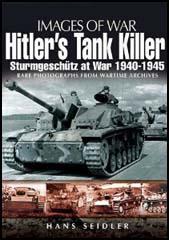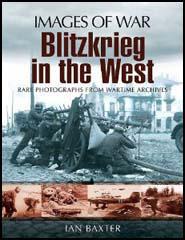Spartacus Review
Volume 44: 25th April, 2010
Nazi Germany

Title: Hitler's Tank Killer
Author: Hans Seidler
Editor:
Publisher: Pen & Sword
Price: £14.99
Bookshop: Amazon
Spartacus Website: German Army
Category:
Sturmgeschütz III was originally designed as an assault weapon, but as war progressed it was increasingly used in a defensive role and evolved into an assault gun and tank destroyer. By 1943 its main role was providing anti-tank support to the units in its area of operation. This consequently led to many StuGs being destroyed in battle. Nonetheless they were very successful as tank killers and destroyed, among others, many bunkers, pillboxes and other defences. The StuG was not considered to be a true tank because it lacked a turret. The gun was mounded directly in the hull, in a casemate-style fashion, with a low profile to reduce vehicle heights, and had a limited lateral traverse of a few degrees in either direction. Thus, the entire vehicle had to be turned in order to acquire targets. Omitting the turret made production much simpler and less costly, enabling greater numbers to be built. Its significantly shorter vertical profile as compared to contemporary tanks made the StuG more difficult to hit. Most assault guns were mounted on the chassis of a Panzer III or Panzer IV, with the resultant model being called either a StuG III or StuG IV respectively. The StuG was one of the most effective tracked vehicles of World War II, and over 10,000 of them were eventually produced. During the course of the war StuG III assault guns were issued to Sturmartillerie Batteries, Sturmgeschütz Abteilungen, Sturmgeschütz Brigades, Sturmartillerie Batteries, Ersatz (Reserve), Abteilungen and Funklenk (Remote Control) Companies. StuG III assault guns served on all fronts of WWII until the end of the war.

Title: Blitzkrieg in the West
Author: Ian Baxter
Editor:
Publisher: Pen & Sword
Price: £14.99
Bookshop: Amazon
Spartacus Website: Blitzkrieg
Category:
This superbly illustrated book captures the dramatic action of May and June 1940. The speed and ferocity of the German onslaught took the Allies by surprise as Hitler’s land and air forces annihilated the inferior opposition. After 9 months stalemate the collapse was cataclysmic and Holland and Belgium quickly fell leaving the British and French forces outflanked and outfought. Panic set in and huge numbers of civilian refugees clogged the roads making the Allies’ withdrawal even more precarious. The miracle of Dunkirk saved vast numbers of British and French forces but could not prevent the surrender of France, leaving Britain to fight on virtually alone. The splendid photographs in this Images of War series book tell the story of this extraordinary period of history. They include previously unseen images of Rommel’s Ghost Division.
